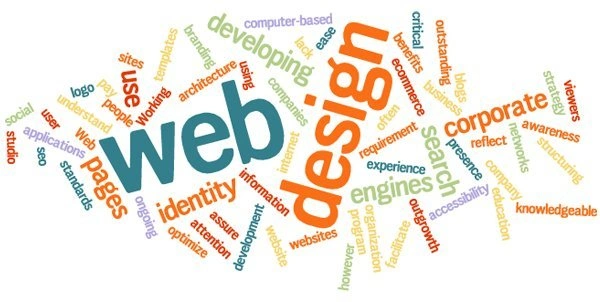Top mobile optimization tips from a professional Website Design Agency
Wiki Article
Discovering Imaginative Trends in Web Design for Modern Companies
The landscape of web design is continuously evolving, showing the dynamic needs of modern-day organizations. Recent fads highlight a choice for minimalism, bold typography, and interesting interactivity. Companies progressively focus on user experience via mobile-first principles and individualized web content. Additionally, a focus on sustainability is getting grip. Understanding these trends is important for businesses intending to stick out in a jampacked market. What implications do these changes hold for the future of digital interaction?Embracing Bold Typography
Bold typography has actually become a specifying aspect in contemporary web design, capturing interest and conveying messages with striking quality. This trend focuses on visually impactful text that improves user engagement and brand name identity. Developers commonly use oversized font styles and unique fonts to produce a pecking order, leading visitors with content effortlessly.
The tactical use of vibrant typography enables efficient narration, enabling brands to communicate their values succinctly. It offers not only visual functions however also practical ones, as it boosts readability throughout devices and display sizes.
As web sites complete for user attention, bold typography stands apart in a saturated electronic landscape. Its versatility allows designers to trying out contrasting formats and colors, further amplifying its efficiency. Eventually, embracing bold typography represents a change in the direction of more communicative and expressive web design, cultivating a deeper connection in between brand names and their target markets.
The Surge of Minimalist Layout
As electronic settings end up being significantly chaotic, the rise of minimalist layout offers an invigorating choice that focuses on simpleness and capability. This layout approach remove unneeded aspects, allowing content to take spotlight. By concentrating on clean lines, adequate white room, and a minimal color combination, minimalist style boosts user experience and enhances navigating.Companies adopting this pattern goal to share their brand message plainly and successfully, cultivating a feeling of tranquility and clarity. The lack of interruptions helps individuals concentrate on vital info, bring about boosted involvement and conversion rates. In addition, minimalist design lines up well with mobile-first techniques, making certain that websites stay accessible and user-friendly across various gadgets.
Eventually, the rise of minimalist layout shows a more comprehensive shift in the direction of prioritizing user demands and choices, making it a powerful tool for modern services looking to make a lasting effect in the digital landscape.
Immersive Animations and Interactivity
While lots of web designers embrace minimal appearances, another engaging fad getting traction is the usage of immersive computer animations and interactivity. This technique enhances user interaction by creating interesting experiences that attract site visitors right into the web content. Developers employ dynamic components such as computer animated histories, scrolling impacts, and interactive infographics to connect complex ideas in an available manner.These animations not just provide aesthetic rate of interest but likewise guide users through the navigation procedure, making interactions a lot more user-friendly. For instance, float results and animated changes can motivate individuals to discover additionally, causing enhanced time spent on the site.
This trend aligns with the broader movement towards storytelling in web design, where animations serve as narrative tools that share brand name messages properly. By incorporating immersive animations and interactivity, organizations can separate themselves in a crowded online landscape, ultimately enhancing user complete satisfaction and brand loyalty.
Mobile-First Layout Concepts
Mobile-first style concepts stress focusing on user experience by guaranteeing internet sites operate effortlessly on smaller displays. This method includes responsive design techniques that adapt to various tool sizes while keeping visual stability. Furthermore, it concentrates on touchscreen navigation style, boosting usability for mobile users.Focusing On User Experience
How can developers properly prioritize user experience in a significantly mobile-centric globe? Highlighting mobile-first layout concepts is crucial, as users primarily involve with internet sites with smart phones. This strategy motivates designers to simplify content, ensuring it is navigable and easily available on smaller displays. Trick methods consist of streamlining navigating, minimizing tons times, and utilizing touch-friendly elements that enhance interactivity. In addition, focusing on readable typography and user-friendly formats can greatly boost user complete satisfaction. Designers need to continually collect user comments to fine-tune their methods, adapting to progressing user demands and preferences. By concentrating on these elements, services can develop an engaging electronic experience that cultivates commitment and drives conversions, eventually lining up with the expectations of today's mobile users.Responsive Layout Strategies
Designers accept receptive design techniques to create adaptive and flexible web experiences that provide to numerous display sizes. This strategy focuses on mobile-first layout concepts, guaranteeing peak performance on smaller gadgets before scaling up for larger screens. By using fluid grids, versatile photos, and media inquiries, designers can preserve a cohesive visual identity throughout all platforms. This approach not just enhances user interaction but also enhances internet search engine positions, as mobile-friendly websites are favored by search algorithms. In addition, receptive layouts allow organizations to reach a wider target market, suiting users on desktop computers, tablets, and smart devices alike. On the whole, implementing these methods is crucial for modern web design, guaranteeing that organizations stay competitive in an ever-evolving that site digital landscape.Touchscreen Navigation Style
With the surge of mobile phones, touchscreen navigating has come to be an essential aspect of web design. Designers are significantly taking on mobile-first principles to enhance user experience and interaction. web design company. Efficient touchscreen navigating prioritizes larger switches and intuitive motions, enabling customers to engage quickly with content. This approach lowers frustration and motivates exploration, as individuals try this out can browse effortlessly with their fingers. In addition, including swipe gestures and faucet functionality satisfies the natural actions of mobile customers. Feedback mechanisms, such as visual hints and computer animations, boost usability better by validating activities. As touchscreens control user interactions, utilizing these design components not just lines up with contemporary expectations but likewise cultivates a much more available and satisfying searching experience for all customersPersonalized User Experiences
What makes a customer feel really involved on a site? The response typically hinges on customized user experiences. By tailoring web content and navigation to private choices, organizations can create a significant connection with their audience. This personalization can be accomplished through numerous approaches, such as examining user habits, utilizing cookies, and offering customized suggestions based on previous communications.For example, e-commerce systems that suggest products based on surfing background not only boost user experience however likewise raise conversion prices. Incorporating vibrant material that adapts to the user's place or time of day can even more enhance interaction.
In addition, customized introductions or messages can make individuals really feel valued and comprehended. As contemporary businesses seek to stand apart in an affordable electronic landscape, welcoming individualized user experiences comes to be crucial, fostering commitment and encouraging repeat visits. Ultimately, this method changes a conventional site into an interactive system that reverberates with its audience.
Sustainability in Web Design
As the electronic landscape remains to advance, the significance of sustainability in web design has gotten considerable interest. Designers are significantly familiar with the ecological effect their productions can have, prompting a shift in the direction of eco-friendly methods (agency for web design). Lasting web design concentrates on maximizing sites to reduce power usage and carbon footprints. Strategies consist of using minimalistic layout concepts, optimizing photos, and employing reliable coding methods to enhance loading ratesFurthermore, the option of holding companies plays an essential role; lots of developers are now selecting environment-friendly holding solutions powered by renewable resource. By prioritizing access and user-friendly navigating, sustainable designs additionally accommodate a wider audience, improving functionality. This mindful method not just interest environmentally-minded customers however additionally adds to the general longevity and effectiveness of web sites. Ultimately, sustainability in web design shows a growing trend towards liable digital techniques that align with modern-day service values.

Regularly Asked Questions
Exactly How Can I Select the Right Color Design for My Internet site?
To select the right color design for a site, one need to think about the brand's identification, target audience, and psychological influence. Using shade theory and testing combinations can boost user experience and visual allure considerably.What Are the most effective Devices for Prototyping Website Design?
The best devices for prototyping internet styles consist of Figma, Sketch, Adobe XD, and InVision. These platforms supply instinctive interfaces, cooperation attributes, and considerable libraries, making them suitable for designers to develop and fine-tune their ideas properly.Exactly how Do I Determine the Performance of My Web Design?
To gauge web design performance, one should examine user involvement metrics, conversion rates, click for more and usability responses (web design company). A/B testing and heatmaps can additionally give understandings right into user actions, directing necessary modifications for enhanced efficiency and user experienceWhat Are Usual Web Design Mistakes to Prevent?
Common web design blunders consist of chaotic formats, bad navigation, sluggish loading times, absence of mobile optimization, insufficient comparison, and disregarding user comments. Preventing these challenges enhances user experience and boosts overall efficiency of the site.Exactly how Usually Should I Update My Internet Site Design?
A website design need to be upgraded every 2 to 3 years, or sooner if substantial adjustments in branding or technology occur. Regular updates keep the site fresh, useful, and straightened with current user expectations.
Report this wiki page